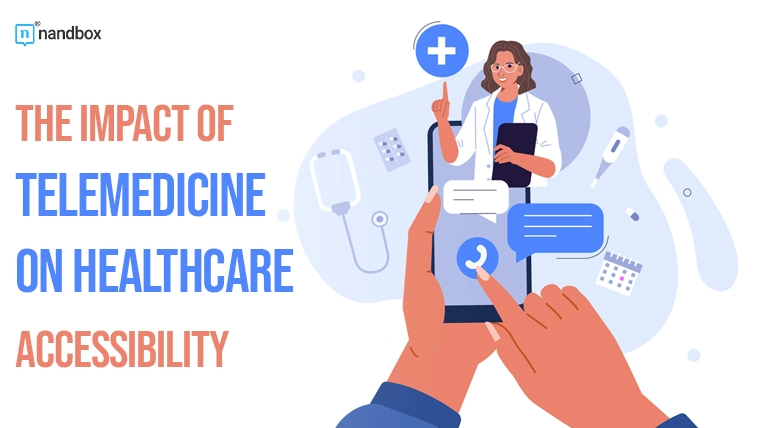Have you ever struggled to get an appointment with your doctor or had to travel long distances just to receive medical care? You’re not alone. Many people face similar challenges, especially those in remote areas or with mobility issues. But what if you could consult with your healthcare provider from the comfort of your own home? This is where the rise of telemedicine comes into play. In this blog, we’ll explore the impact and the rise of telemedicine on healthcare accessibility and address the concerns you might have about this rapidly growing technology.
The Rise of Telemedicine
Telemedicine has a long history, dating back to the early 20th century, when radio was used to give medical advice to sailors at sea. However, it is only in the last two decades that telemedicine has evolved into a comprehensive healthcare solution.
The widespread availability of the internet and advancements in medical technology have driven this evolution, making the rise of telemedicine a critical component of modern healthcare.
Several factors have contributed to the of telemedicine:
- Technological Advancements: Improved internet connectivity and the proliferation of smartphones and tablets have made telemedicine accessible to a larger population.
- Policy Changes: Governments and healthcare organizations have implemented policies that support telemedicine, especially in response to the COVID-19 pandemic.
- Consumer Demand: Patients increasingly prefer the convenience of virtual consultations, which eliminate the need for travel and reduce waiting times.
Enhancing Healthcare Accessibility
One of the most significant impacts of the rise of telemedicine is its ability to bridge the gap in healthcare accessibility in rural areas. Many rural communities face challenges such as a shortage of healthcare providers, long travel distances to the nearest medical facility, and limited access to specialized care. Telemedicine addresses these issues by providing:
- Virtual Consultations: Patients can consult with healthcare providers from the comfort of their homes, reducing the need for travel.
- Specialist Access: Rural patients can access specialist care that may not be available locally.
- Continuous Monitoring: Telemedicine allows for continuous monitoring of chronic conditions, ensuring timely intervention and reducing hospital admissions.
Cost Savings for Patients & Healthcare Providers
Telemedicine can significantly reduce healthcare costs for patients. By eliminating the need for travel and reducing time off work, patients can save on both direct and indirect expenses. Additionally, telemedicine can lead to better management of chronic conditions, reducing the need for costly emergency room visits and hospitalizations.
Healthcare providers also benefit from telemedicine through cost savings and increased efficiency. Virtual consultations can reduce overhead costs associated with running a physical clinic. Moreover, telemedicine allows providers to see more patients in less time, improving productivity and patient satisfaction.
Improving Access for Underserved Populations
Telemedicine also plays a crucial role in improving access to healthcare for underserved populations, including:
- Low-Income Communities: Telemedicine can reduce healthcare costs by eliminating travel expenses and minimizing time off work.
- Older People and Disabled Individuals: For those with mobility issues, telemedicine offers a convenient way to receive medical care without the need to leave their homes.
- Minority Communities: Telemedicine can help address healthcare disparities by providing access to culturally competent care providers who may not be available locally.
Enhancing Quality of Care
Continuity of Care
Telemedicine enhances the continuity of care by facilitating regular follow-ups and ongoing monitoring. Patients with chronic conditions can receive timely interventions, reducing the risk of complications and improving health outcomes. Additionally, certain supplements like sucrosomial magnesium can aid in managing chronic conditions by improving nutrient absorption and overall health.
Access to Specialists
Telemedicine provides patients with access to a broader range of specialists. This is particularly important for those with rare or complex conditions that require specialized expertise. Through telemedicine, patients can receive expert opinions without the need for long-distance travel.
Patient Engagement
Telemedicine fosters greater patient engagement by making it easier for patients to communicate with their healthcare providers. Through virtual consultations, patients can ask questions, discuss concerns, and receive personalized advice, leading to better adherence to treatment plans and improved health outcomes.
Telemedicine vs. Traditional Healthcare
| Aspect | Telemedicine | Traditional Healthcare |
| Accessibility | Remote consultations from any location | Requires travel to healthcare facilities |
| Cost | Reduces travel and indirect expenses | Includes travel costs and time off work |
| Specialist Access | Easy access to a wide range of specialists | Limited to local availability |
| Continuity of Care | Facilitates regular follow-ups and monitoring | May involve longer intervals between visits |
| Technological Requirements | Requires internet access and digital literacy | No internet or digital skills needed |
Challenges and Solutions
Technological Barriers
Despite its many benefits, telemedicine faces several challenges. Technological barriers, such as lack of access to high-speed internet or digital literacy, can limit the adoption of telemedicine in certain populations. Addressing these barriers requires:
- Infrastructure Development: Investing in internet infrastructure to ensure high-speed connectivity in rural and underserved areas.
- Digital Literacy Programs: Implementing programs to educate patients and healthcare providers on how to use telemedicine platforms effectively.
Regulatory and Reimbursement Issues
Regulatory and reimbursement issues also pose challenges to the widespread adoption of telemedicine. Different states and countries have varying regulations regarding telemedicine, and reimbursement policies can be inconsistent. Solutions include:
- Unified Regulations: Developing unified regulations that facilitate the use of telemedicine across different regions.
- Reimbursement Policies: Establishing clear and consistent reimbursement policies to ensure that healthcare providers are adequately compensated for telemedicine services.
Privacy and Security Concerns
Privacy and security concerns are paramount in telemedicine, as sensitive patient information is transmitted electronically. Ensuring the security of telemedicine platforms involves:
- Robust Security Measures: Implementing encryption and other security measures to protect patient data.
- Compliance with Regulations: Ensuring that telemedicine platforms comply with healthcare privacy regulations such as HIPAA.
Future of Telemedicine
The future of telemedicine lies in its integration with traditional healthcare systems. Hybrid models that combine in-person and virtual care can provide the best of both worlds, offering patients the flexibility of telemedicine while maintaining the benefits of face-to-face interactions.
Advancements in technology will continue to drive the evolution of telemedicine. Innovations such as artificial intelligence, wearable devices, and remote monitoring tools will enhance the capabilities of telemedicine, allowing for more accurate diagnoses and personalized treatment plans.
Telemedicine has the potential to make a global impact by improving healthcare accessibility in developing countries. By leveraging telemedicine, healthcare providers can reach remote and underserved populations, addressing healthcare disparities on a global scale.
Frequently Asked Questions
- Can telemedicine completely replace in-person visits?
While telemedicine offers many benefits, it is not a complete replacement for in-person visits. Some medical conditions and treatments require physical examinations and face-to-face interactions with healthcare providers.
- How does telemedicine improve access to healthcare?
Telemedicine makes it easier for patients in remote or underserved areas to receive medical care without the need for long-distance travel, and it provides access to specialists who may not be locally available.
- Is telemedicine safe and secure?
Yes, telemedicine platforms are designed with robust security measures, including encryption, to protect patient information. They also comply with healthcare privacy regulations such as HIPAA.
- What are the cost benefits of telemedicine?
Telemedicine reduces costs by eliminating travel expenses, minimizing time off work, and reducing the need for expensive emergency room visits and hospitalizations.





